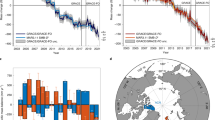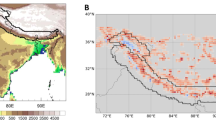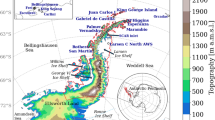Abstract
Identifying mechanisms driving spatially heterogeneous glacial mass-balance patterns in the Himalaya, including the ‘Karakoram anomaly’, is crucial for understanding regional water resource trajectories. Streamflows dependent on glacial meltwater are strongly positively correlated with Karakoram summer air temperatures, which show recent anomalous cooling. We explain these temperature and streamflow anomalies through a circulation system—the Karakoram vortex—identified using a regional circulation metric that quantifies the relative position and intensity of the westerly jet. Winter temperature responses to this metric are homogeneous across South Asia, but the Karakoram summer response diverges from the rest of the Himalaya. We show that this is due to seasonal contraction of the Karakoram vortex through its interaction with the South Asian monsoon. We conclude that interannual variability in the Karakoram vortex, quantified by our circulation metric, explains the variability in energy-constrained ablation manifested in river flows across the Himalaya, with important implications for Himalayan glaciers’ futures.
This is a preview of subscription content, access via your institution
Access options
Access Nature and 54 other Nature Portfolio journals
Get Nature+, our best-value online-access subscription
$29.99 / 30 days
cancel any time
Subscribe to this journal
Receive 12 print issues and online access
$209.00 per year
only $17.42 per issue
Buy this article
- Purchase on Springer Link
- Instant access to full article PDF
Prices may be subject to local taxes which are calculated during checkout





Similar content being viewed by others
References
Hewitt, K. The Karakoram anomaly? Glacier expansion and the ‘Elevation Effect,’ Karakoram Himalaya. Mount. Res. Dev. 25, 332–340 (2005).
Bolch, T. et al. The state and fate of Himalayan glaciers. Science 336, 310–314 (2012).
Kääb, A., Berthier, E., Nuth, C., Gardelle, J. & Arnaud, Y. Contrasting patterns of early twenty-first-century glacier mass change in the Himalayas. Nature 488, 495–498 (2012).
Gardelle, J., Berthier, E. & Arnaud, Y. Slight mass gain of Karakoram glaciers in the early twenty-first century. Nature Geosci. 5, 322–325 (2012).
Jacob, T., Wahr, J., Pfeffer, T. W. & Swenson, S. Recent contributions of glaciers and ice caps to sea level rise. Nature 482, 514–518 (2012).
Pratap, B., Dobhal, D. P., Bhambri, R., Mehta, M. & Tewari, V. C. Four decades of glacier mass balance observations in the Indian Himalaya. Reg. Environ. Change 16, 643–658 (2016).
Bolch, T., Pieczonka, T., Mukherjee, K. & Shea, J. Brief communication: Glaciers in the Hunza catchment (Karakoram) have been nearly in balance since the 1970s. Cryosphere 11, 531–539 (2017).
Zhou, Y., Li, Z. & Li, J. I. Slight glacier mass loss in the Karakoram region during the 1970s to 2000 revealed by KH-9 images and SRTM DEM. J. Glaciol. 63, 331–342 (2017).
Fowler, H. J. & Archer, D. R. Conflicting signals of climatic change in the Upper Indus Basin. J. Clim. 19, 4276–4293 (2006).
Archer, D. R. Contrasting hydrological regimes in the upper Indus Basin. J. Hydrol. 274, 198–210 (2003).
Forsythe, N., Fowler, H. J., Kilsby, C. G. & Archer, D. R. Opportunities from remote sensing for supporting water resources management in village/valley scale catchments in the Upper Indus Basin. Wat. Res. Manag. 26, 845–871 (2012).
Archer, D. R., Forsythe, N., Fowler, H. J. & Shah, S. M. Sustainability of water resources management in the Indus Basin under changing climatic and socio economic conditions. Hydrol. Earth Syst. Sci. 14, 1669–1680 (2010).
Immerzeel, W. W., Van Beek, L. P. H. & Bierkens, M. F. P. Climate change will affect the Asian water towers. Science 328, 1382–1385 (2010).
Archer, D. R. & Fowler, H. J. Spatial and temporal variations in precipitation in the Upper Indus Basin, global teleconnections and hydrological implications. Hydrol. Earth Syst. Sci. 8, 47–61 (2004).
Forsythe, N., Kilsby, C. G., Fowler, H. J. & Archer, D. R. Assessment of runoff sensitivity in the upper Indus Basin to interannual climate variability and potential change using MODIS satellite data products. Mount. Res. Dev. 32, 16–29 (2012).
Yao, T. et al. Different glacier status with atmospheric circulations in Tibetan Plateau and surroundings. Nat. Clim. Change 2, 663–667 (2012).
Mölg, T., Maussion, F. & Scherer, D. Mid-latitude westerlies as a driver of glacier variability in monsoonal High Asia. Nat. Clim. Change 4, 68–73 (2014).
Yadav, R. K. Changes in the large-scale features associated with the Indian summer monsoon in the recent decades. Int. J. Climatol. 29, 117–133 (2009).
Yadav, R. K., Rupa Kumar, K. & Rajeevan, M. Increasing influence of ENSO and decreasing influence of AO/NAO in the recent decades over northwest India winter precipitation. J. Geophys. Res. 114, D12112 (2009).
Yadav, R. K., Ramu, D. A. & Dimri, A. P. On the relationship between ENSO patterns and winter precipitation over North and Central India. Glob. Planet. Change 107, 50–58 (2013).
Syed, F. S., Giorgi, F., Pal, J. S. & King, M. P. Effect of remote forcings on the winter precipitation of central southwest Asia part 1: observations. Theor. Appl. Climatol. 86, 147–160 (2006).
Ding, Q., Wang, B., Wallace, J. M. & Branstator, G. Tropical-extratropical teleconnections in boreal summer: observed interannual variability. J. Clim. 24, 1878–1896 (2011).
Ding, Q. & Wang, B. Circumglobal teleconnection in the Northern Hemisphere summer. J. Clim. 18, 3483–3505 (2005).
Cannon, F., Carvalho, L. M. V., Jones, C. & Bookhagen, B. Multi-annual variations in winter westerly disturbance activity affecting the Himalaya. Clim. Dyn. 44, 441–455 (2015).
Zhao, Y. et al. Impact of the middle and upper tropospheric cooling over central Asia on the summer rainfall in the Tarim Basin, China. J. Clim. 27, 4721–4732 (2014).
Oliver, J. E. Encyclopedia of World Climatology 820–822 (Springer, 2005).
Webster, P. J. & Yang, S. Monsoon and ENSO: selectively interactive systems. Q. J. R. Meteorol. Soc. 118, 877–926 (1992).
Yadav, R. K. On the relationship between Iran surface temperature and northwest India summer monsoon rainfall. Int. J. Climatol. 36, 4425–4438 (2016).
Archer, D. R. Hydrological implications of spatial and altitudinal variation in temperature in the upper Indus basin. Nord. Hydrol. 35, 209–222 (2004).
Forsythe, N. et al. A detailed cloud fraction climatology of the Upper Indus Basin and its implications for near-surface air temperature. J. Clim. 28, 3537–3556 (2015).
Dash, S. K., Kulkarni, M. A., Mohanty, U. C. & Prasad, K. Changes in the characteristics of rain events in India. J. Geophys. Res. 114, D10109 (2009).
Bollasina, M. A., Ming, Y. & Ramaswamy, V. Anthropogenic aerosols and the weakening of the South Asian summer monsoon. Science 334, 502–505 (2011).
Saha, A., Ghosh, S., Sahana, A. S. & Rao, E. P. Failure of CMIP5 climate models in simulating post-1950 decreasing trend of Indian monsoon. Geophys. Res. Lett. 41, 7323–7330 (2014).
Saeed, F., Hagemann, S. & Jacob, D. A framework for the evaluation of the South Asian summer monsoon in a regional climate model applied to REMO. Int. J. Climatol. 32, 430–440 (2012).
Sharif, M., Archer, D. R., Fowler, H. J. & Forsythe, N. Trends in timing and magnitude of flow in the Upper Indus Basin. Hydrol. Earth Syst. Sci. 17, 1503–1516 (2013).
Archer, C. L. & Caldeira, K. Historical trends in the jet streams. Geophys. Res. Lett. 35, L08803 (2008).
Wu, G. et al. Tibetan Plateau climate dynamics: recent research progress and outlook. Natl Sci. Rev. 2, 100–116 (2015).
Mihalcea, C. et al. Spatial distribution of debris thickness and melting from remote-sensing and meteorological data, at debris-covered Baltoro Glacier, Karakoram, Pakistan. Ann. Glaciol. 48, 49–57 (2008).
Scherler, D., Bookhagen, B. & Strecker, M. R. Spatially variable response of Himalayan glaciers to climate change affected by debris cover. Nat. Geosci. 4, 156–159 (2011).
Heid, T. & Kääb, A. Repeat optical satellite images reveal widespread and long term decrease in land-terminating glacier speeds. Cryosphere 6, 467–478 (2012).
Uppala, S. M. et al. The ERA-40 re-analysis. Q. J. R. Meteorol. Soc. 131, 2961–3012 (2005).
Dee, D. P. et al. The ERA-Interim reanalysis: configuration and performance of the data assimilation system. Q. J. R. Meteorol. Soc. 137, 553–597 (2011).
Ebita, A. et al. The Japanese 55-year reanalysis ‘JRA-55’: an interim report. Sci. Online Lett. Atmos. 7, 149–152 (2011).
Rienecker, M. M. et al. MERRA: NASA’s modern-era retrospective analysis for research and applications. J. Clim. 24, 3624–3648 (2011).
Saha, S. et al. The NCEP climate forecast system reanalysis. Bull. Am. Meteorol. Soc. 91, 1015–1057 (2011).
Collier, E. et al. High-resolution interactive modelling of the mountain glacier–atmosphere interface: an application over the Karakoram. Cryosphere 7, 779–795 (2013).
Lawrimore, J. H. et al. An overview of the Global Historical Climatology Network monthly mean temperature data set, version 3. J. Geophys. Res. 116, D19121 (2011).
Khan, A., Richards, K. S., Parker, G. T., McRobie, A. & Mukhopadhyay, B. How large is the Upper Indus Basin? The pitfalls of auto-delineation using DEMs. J. Hydrol. 509, 442–453 (2013).
Arendt, A. et al. Randolph Glacier Inventory—A Dataset of Global Glacier Outlines: Version 5.0. Global Land Ice Measurements from Space (Digital Media, 2015); http://www.glims.org/RGI/00_rgi50_TechnicalNote.pdf
Pfeffer, W. T. et al. The Randolph Glacier Inventory: a globally complete inventory of glaciers. J. Glaciol. 60, 537–552 (2014).
Maussion, F. et al. Precipitation seasonality and variability over the Tibetan Plateau as resolved by the High Asia Reanalysis. J. Clim. 27, 1910–1927 (2014).
Oliphant, T. E. Python for scientific computing. Comput. Sci. Eng. 9, 4160250 (2007).
The NCAR Command Language (v.6.4.0). (UCAR/NCAR/CISL/TDD, 2017); http://dx.doi.org/10.5065/D6WD3XH5
Hinsen, K. In Computational Science—ICCS 2002 (eds Sloot, P. M. A., Hoekstra, A. G., Tan, C. J. K. & Dongarra, J. J.) 2331 (Springer, 2002).
Holderness, T. Python Spatial Image Processing (PyRaster) (2011); https://github.com/talltom/PyRaster
JRA-55 Japanese 55-year Reanalysis, Daily 3-Hourly and 6-Hourly Data (Research Data Archive and Computational and Information Systems Laboratory NCAR, 2011); http://dx.doi.org/10.5065/D6HH6H41
NCEP Climate Forecast System Reanalysis (CFSR) 6-hourly Products, January 1979 to December 2010 (Research Data Archive and Computational and Information Systems Laboratory NCAR, 2011); http://dx.doi.org/10.5065/D69K487J
Acknowledgements
Karakoram T2 m observations were obtained both directly from the Pakistan Meteorological Department and via the Global Change Impacts Studies Centre (Islamabad). Upper Indus tributary streamflow observations were obtained, via intermediaries including D. Hashmi, from the Pakistan Water and Power Development Authority. This study was made possible by financial support from the Leverhulme Trust via a Philip Leverhulme Prize (2011) awarded to H.J.F. Additional financial support during the developmental stages of this work was provided by the British Council Pakistan (PMI2/RCPK06 and INSPIRE/SP0015 grants), the UK Natural Environment Research Council (NERC) as a Postdoctoral Fellowship award NE/D009588/1 (2006–2010) to H.J.F., and a US National Science Foundation (NSF) Graduate Research Fellowship (ID:2006037346) award to N.F. (2006–2010). H.J.F. is supported by a Royal Society Wolfson Research Merit Award (WM140025). X.-F.L., S.B. and H.J.F. are supported by the INTENSE project through the European Research Council (grant ERC-2013-CoG-617329). D.P. is supported by a UK Engineering and Physical Sciences Research Council (EPSRC) doctoral training award (EP/M506382/1).
Author information
Authors and Affiliations
Contributions
N.F. designed the study, processed and analysed the data, created most of the figures (Figs 1, 4, 5 and all Supplementary Figures except Supplementary Fig. 4), and wrote the paper. All other co-authors wrote and edited the paper and assisted in interpretations. H.J.F. provided overall leadership, interpretation and integration of results and methodological guidance. S.B. focused on readability for the broader Nature Climate Change audience and methodological guidance. X.-F.L. provided input on climatological mechanisms and created Figs 2, 3 and Supplementary Fig. 4. D.P. provided input on recent variability of Indus tributary streamflows.
Corresponding author
Ethics declarations
Competing interests
The authors declare no competing financial interests.
Supplementary information
Supplementary Information
Supplementary Information (PDF 8937 kb)
Rights and permissions
About this article
Cite this article
Forsythe, N., Fowler, H., Li, XF. et al. Karakoram temperature and glacial melt driven by regional atmospheric circulation variability. Nature Clim Change 7, 664–670 (2017). https://doi.org/10.1038/nclimate3361
Received:
Accepted:
Published:
Issue Date:
DOI: https://doi.org/10.1038/nclimate3361
This article is cited by
-
Characteristic Changes in the Strengthening Western Disturbances over Karakoram in Recent Decades
Asia-Pacific Journal of Atmospheric Sciences (2024)
-
Link between the atmospheric thermal condition over the Tibetan–Iranian Plateaus and Eurasian–African climate through the Asian westerly jet stream
Theoretical and Applied Climatology (2024)
-
Anthropogenic forcing and Pacific internal variability-determined decadal increase in summer precipitation over the Asian water tower
npj Climate and Atmospheric Science (2023)
-
Wet bias of summer precipitation in the northwestern Tibetan Plateau in ERA5 is linked to overestimated lower-level southerly wind over the plateau
Climate Dynamics (2023)
-
Assessment of Hydro-climatic Variables and Its Impact on River Flow Regime in the Sub-basins of the Upper Indus Basin
Earth Systems and Environment (2023)



